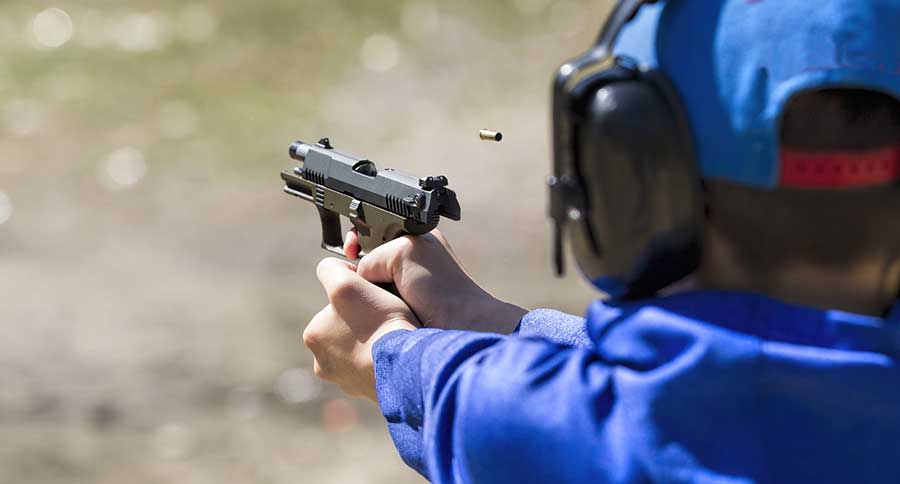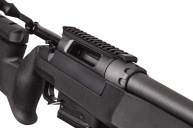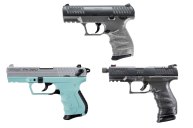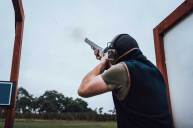Preparing and teaching a kid to shoot a gun is one of the most rewarding things that you can do.
Let's get right to the point: teaching gun safety to a first time shooter goes without saying. It is rule number one.
But when you're teaching a young child or teen how to handle a gun, it becomes even more important.
You've been a responsible gun owner and kept them away from your children, but perhaps now it's time to show them up close. You've got a promise to keep: get them in their hands when they've proven that they are ready.
The difference here is to start them out by getting them up close to a cleared firearm—any firearm—if for no other reason than to help them alleviate any underlying fear.
Make a firearm accessible in a way that is prudently safe while being close enough to touch and feel. Kids like to be hands-on when it comes to new things and even firearms, when handled properly, should be no different.
Here are some other pointers on introducing kids to guns. It's not an end-all, be-all list of steps to take, and everyone is going to approach it with slight differences.
But the most pertinent points should be clear: be safe, have fun, and pass on the meaning of responsible gun ownership.
Take Away the Mystery
https://www.youtube.com/watch?v=4mZ2Hcovxm8&feature=emb_title
This is the information age, and not all information is true or justifiable. That means that by now, kids have heard all about how big, bad, and dangerous firearms are. Some kids might not want to admit that they are a little scared of them, so you may want to start with something small like a .22-caliber handgun or long rifle.
Safety rules and firearm safety go hand in hand and need to start at a young age, which means that safe direction and instruction starts in the home with a responsible discussion about gun handling.
For a parent or guardian that would like to go this direction with a house full of next generation, new shooters, we'll discuss how to find and choose a good procedure to start them off right. Many of us started out with the venerable BB gun or a pellet gun; sometimes with adult supervision, and honestly, sometimes without. Those of us who were lucky enough to be raised in a responsible gun owning household remember being a part of the generation that knew what gun safety meant from a young age.
Not every kid grew up with a gun in the house, and we can help grow shooting sports by showing them how. Teaching kids to be comfortable around firearms means letting them put their hands on one, under adult supervision. Once we show them the basics and demand their respect, they'll start to feel more comfortable.
Getting Started
When is a child ready to shoot?
Some factors conducive to the shooting sports are a child's natural maturity level, strength, and even desire. Does the child even want to start shooting, or do you want it more? Since there are very few states that have no age limit for hunting, Wisconsin being one, and certainly none for shooting, you will need your own good judgement as to when the time is right for your child. That's a big decision to make.
In Kansas for instance, youth shooters as young as eight years old are participating in the "First Shots" program under strict (but meaningful and enthusiastic) adult supervision. Programs like these let a youth shooter begin to learn the rules of firearms safety, see immediate results, and feel a part of a group.
Girls and boys can together learn one of life's greatest lessons: after their parents and their teachers, there are other good folks in the world that will expect something from them, such as respect, full attention, and willingness to follow directions.
Remember that we want to introduce them to live firearms now, so no rules are too demanding. This may seem like a bit of an unrelated analogy, but I can equate teaching a kid to shoot to dog training. My first lesson from a professional dog trainer was simple: every dog needs a good leader, and after a training session, there needs to be some kind of reward, usually in the form of enjoyable playtime.
For kids learning to shoot, much the same can be said. First they will need to be regimented in the main safety rules by a good leader. They'll need to treat every firearm as if it were loaded, keep their finger off of the trigger until the target is sighted, know exactly what their target is and what's beyond it, and always have the muzzle pointed in a safe direction.
How you explain those rules, define those terms, and enforce their repetition is partly up to you. But if you don't get those important rules across, you're failing at your job.
Now that you have instilled these rules, how well do they know them? It might seem like a moot point to you and I, but this is why we test our children. Once you (or better yet, a professional instructor) are satisfied that they know these rules and know them well, it's time to get out on the range!
Gun Handling
Like every good parent or guardian, you've done your duty, and now comes your own test. You have to allow them to participate in what they have learned, and try to keep your hands off. This does NOT mean you can sit back and allow mistakes to happen, but it will mean less hovering and handholding, and more confidence in their handling of firearms.
Even for lifelong gun owners it can be a test of patience and their own will to step back and watch a kid pull the trigger without trying to do it for them.
Pumping BBs, pellets, or airsoft ammo into the air doesn't really compare with live ammunition, but it will give them a good start. Not only that, but the commensurate dry-fire drills instill a measure of hand-eye coordination that can't be taken lightly when putting the firearm right into their hands, maybe for the first time.
Since it almost goes without saying that most of us took our first shot by the crack of a .22, that's still a great place to start. Putting something too big in their hands may sway their confidence a bit, so the diminutive and subtle .22 has always been a surefire way to start them off.
Sometimes it's best to use a single shot firearm, as they will get a shot off and then have a clear gun after ejecting the spent shell.
Once they get familiar with the gun they are using, only then it will be time to up the ante and hand them one that uses a magazine.
Using a multi-shot gun comes with a lesson on how to load the magazine, add the magazine to the firearm, and use an interior magazine if that's part of the gun's design. Here is where calm and precise instruction comes into play with a big discussion about muzzle discipline.
In fact, watch just two-minutes of this venerable Hickok45 video, even though you will want to watch the entire piece:
Did anybody else cringe during the first two minutes? Luckily for us, Hickok45 knows what he is doing and is one of our best resources when it comes to firearms and firearm information. He's providing even veteran gun owners like us a never ending supply of good advice.
Follow it!
Safety First
It has been said that there's really no such thing as an "accidental discharge" of firearms, only negligent ones. This might be a good place to be a little hard, but fair, on a youth shooter. There's an old saying that "knowledge is power," but when it comes to the shooting sports, a better use of the phrase might be "knowledge breeds confidence."
Once a youth shooter learns to use any firearm they become confident with it, enough that they can get to the point of handling one without adult supervision. And that's really the point, isn't it? It's quite simple to reinforce safety and review the simple glossary terminology at the same time: action, ammo, barrel, bore, breech, butt, caliber, dry firing, loaded, receiver, round, safety, trigger, trigger guard, and those are just the tip of the iceberg.
The four basic gun safety rules that we live by are never too familiar to review again and again:
1. Treat every firearm as if it were loaded.
2. Never let the muzzle of the firearm cover anything that you do not wish to destroy.
3. Keep your finger off of the trigger until you have your sights on the target and are ready to shoot.
4. Be sure of your target and what is beyond it.
Some of you might have skimmed over those rules, and that's because we all know them like the back of our own hand from a lifetime of reviewing them. If we expect our children to take them seriously, we must know them by heart ourselves.
Certainly the most important aspect of teaching a kid to shoot is safety, and most critically, what a loaded firearm can do, but that's by no means all there is to it.
Every child needs to understand that their eyes and ears need to be protected. They might as well get used to the fact that those body parts will be covered while they use the firearm.
Inexpensive foam ear plugs don't work as well as a pair of high-quality electronic ones, but they sure work better than nothing. The same can be said for eye protection. They are usually a polycarbonate, wrap around style, and ANSI-rated. Make sure you find something that fits them and is comfortable, especially since you aren't going to let them shoot without wearing protective gear.
Proper Instruction
I coached youth sports for many years as a volunteer including baseball, basketball, soccer, and football, but when it comes right down to it, I only ever tried to instruct my own child in using a firearm. The best proper shooting instruction comes from a pro. Youth shooting instructors are usually adult shooting instructors as well and tend to have many years of experience working with kids.
And it's as easy as contacting the NRA.
The National Rifle Association has a plethora of resources when it comes to finding a youth shooting instructor, and you can even find opportunities to become a youth shooting instructor. Honestly, a simple Google search of "child gun safety class near me" will give you an easy head start to finding the quality shooting education that your child deserves. Some may be lucky enough to see it start right in their local school!
When you find a prospective instructor, don't be afraid to communicate with them via their contact page. Call them and question them. They understand what it means to put a firearm in your child's hand better than anyone, and they'll have the answers that you need.
Ask them about their gun range and range rules, the fees involved, and the age groups they've worked with. It may be a good idea to go and visit them beforehand to see what they are really all about.
Remember, one of the best reasons to give kids firearm instruction is so that they'll carry on the traditions we've built for ourselves. Hunting, range shooting, and plinking are all activities we love and want to pass down.
Teaching a kid the rules of firearm safety and how to shoot is one of the best things you can do.
Looking for a little more? Follow my webpage, or on Facebook and Twitter.
NEXT: MINNESOTA SCHOOLS COULD MAKE FIREARMS SAFETY PART OF PHYSICAL EDUCATION
WATCH




